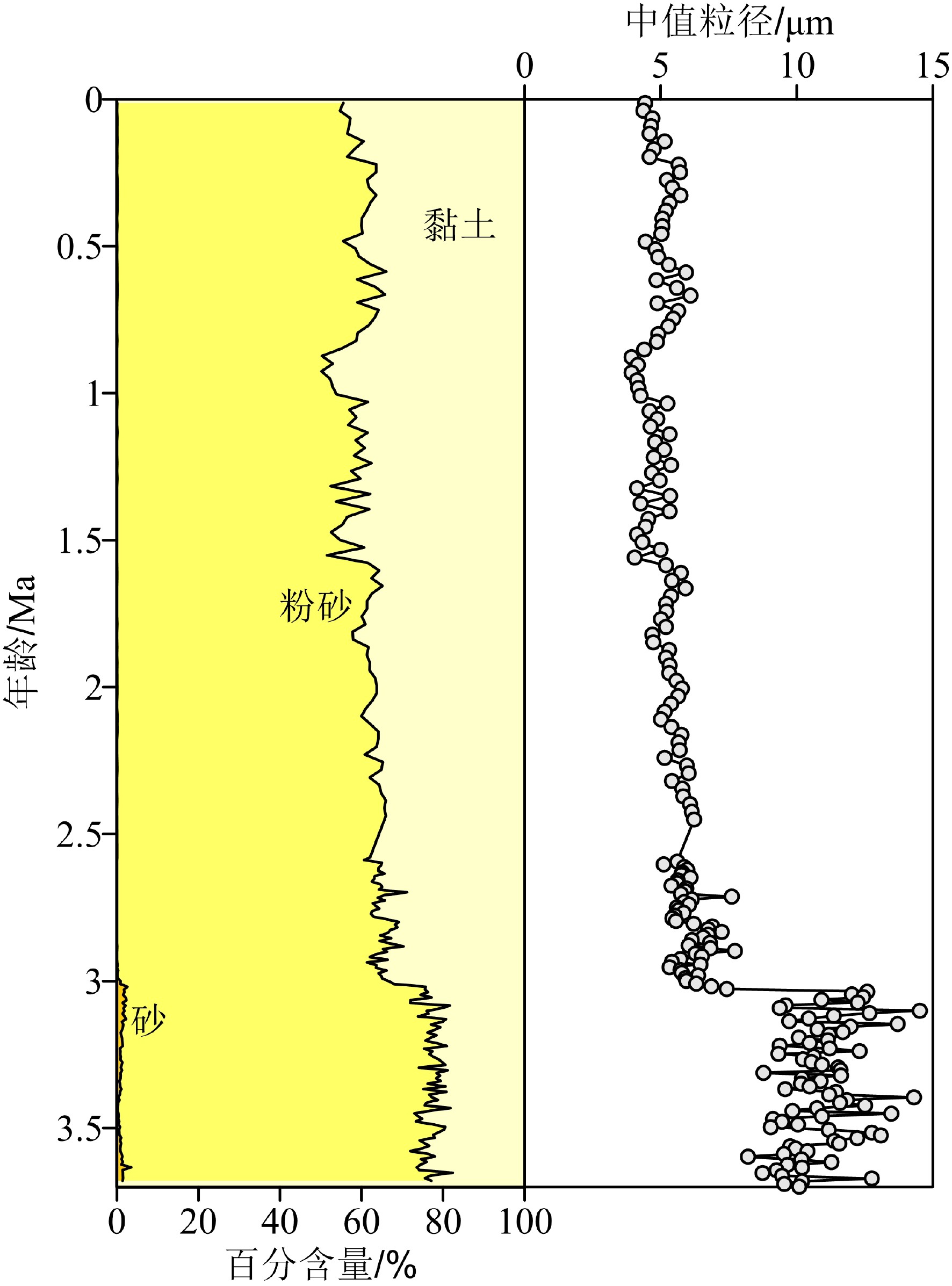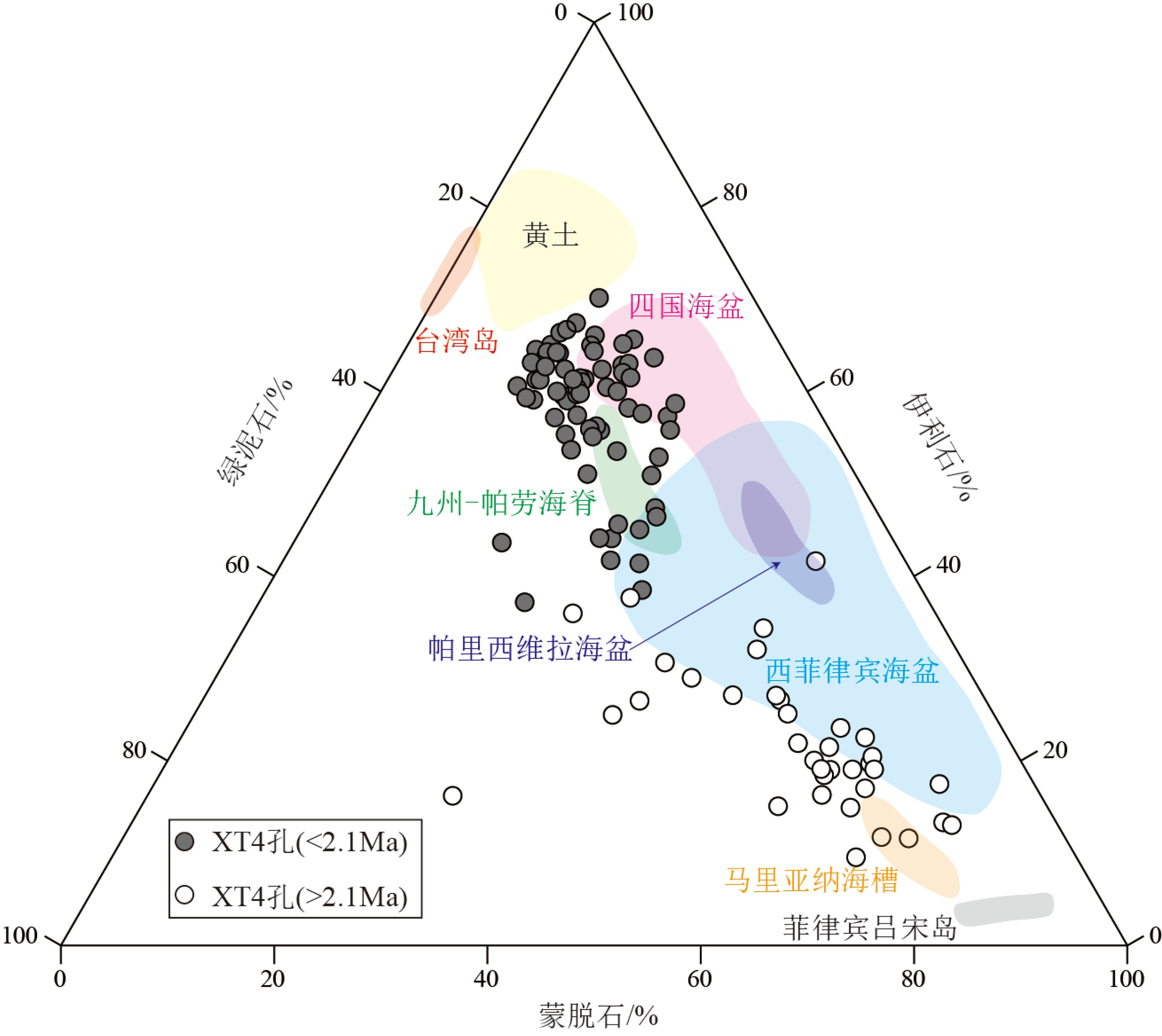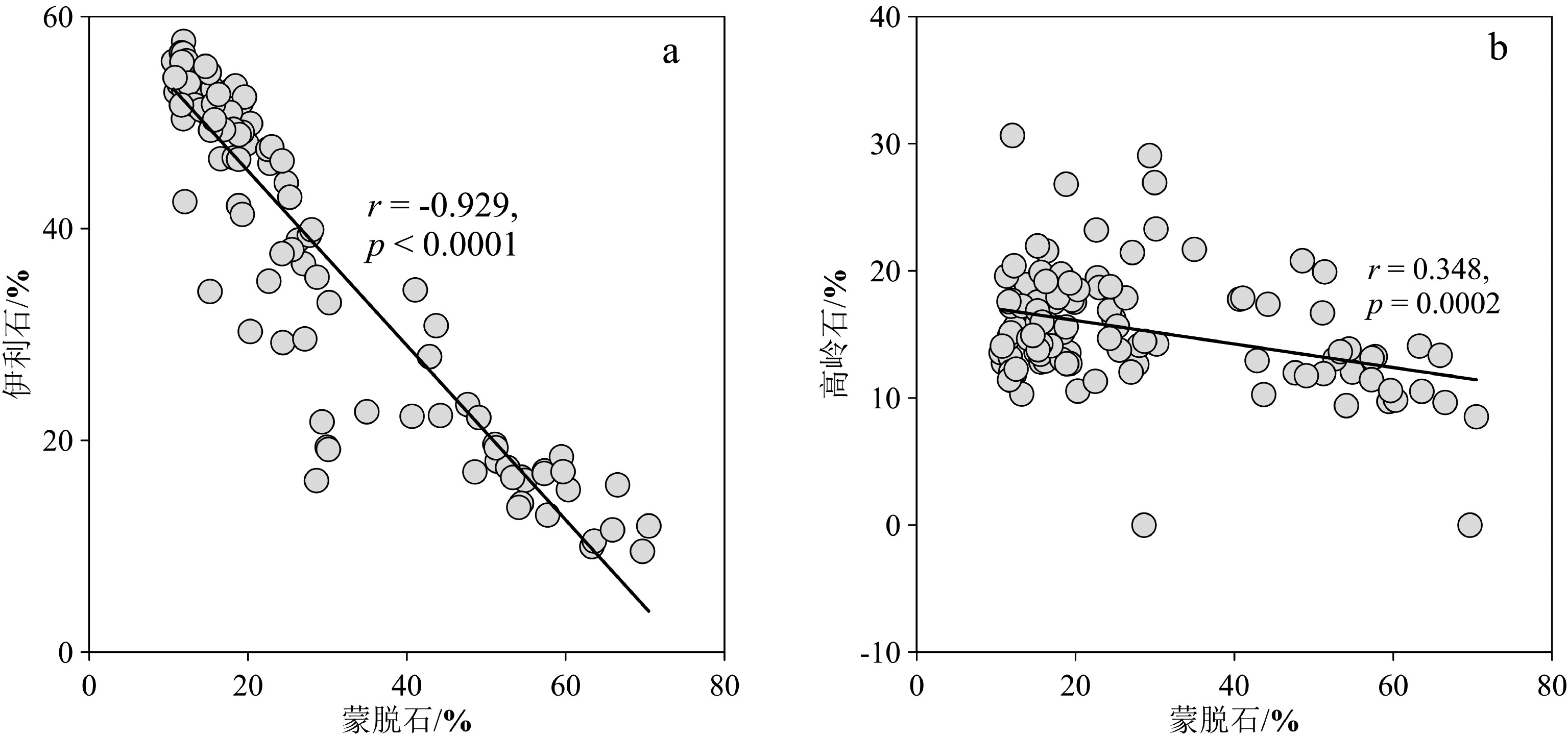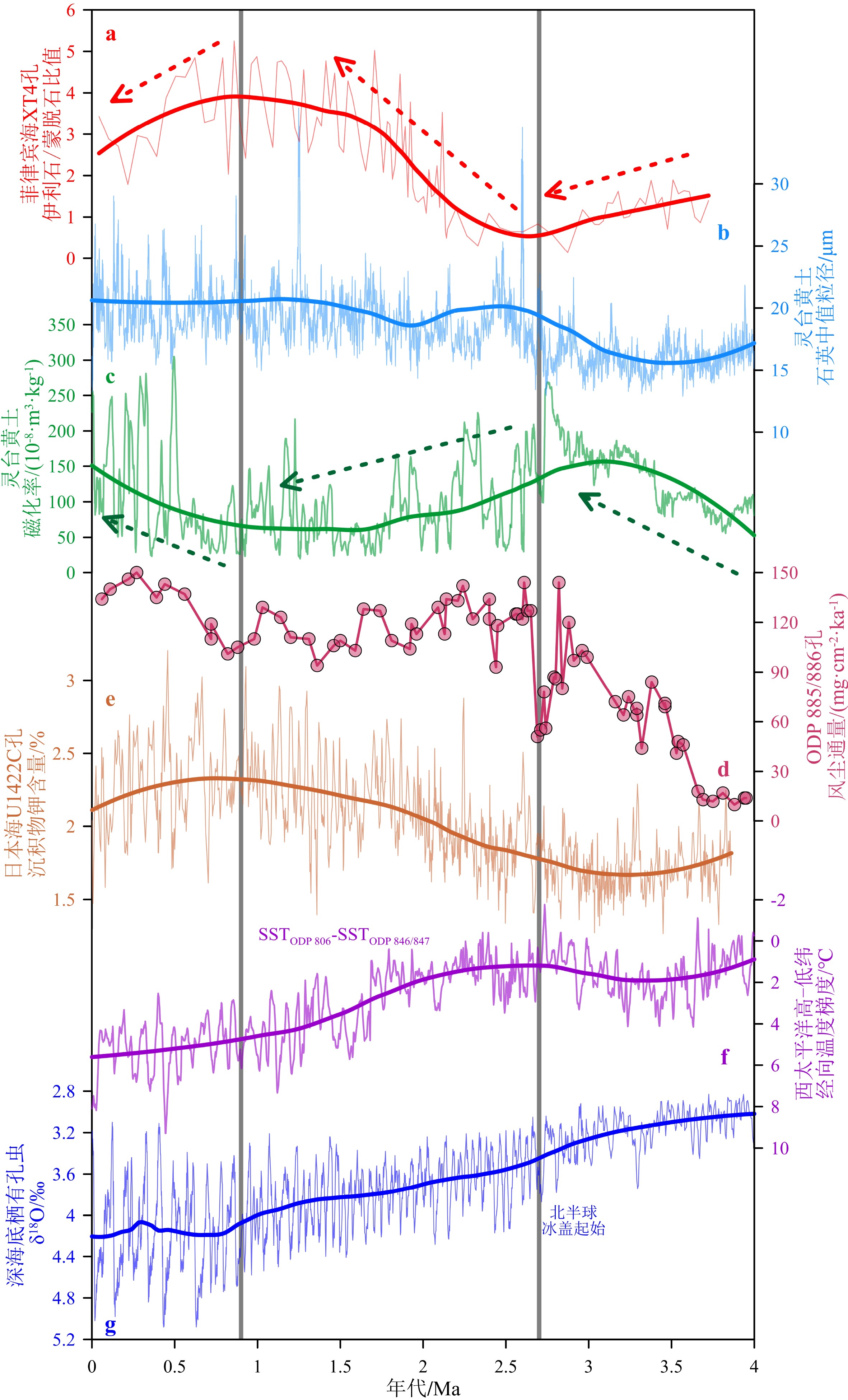Evolution of clay minerals assemblages since Late Pliocene and its paleoenvironmental implications: Evidence from Core XT4 of the Philippine Sea Basin
-
摘要: 菲律宾海是典型风尘汇聚区,菲律宾海远离吕宋岛的深海沉积物是重建构造尺度亚洲风尘演化历史的良好载体。选取菲律宾海盆XT4孔沉积物开展了黏土矿物研究,并结合前人研究成果,在明确该孔黏土矿物来源的基础上,探讨了晚上新世以来亚洲风尘的演化历史及其可能的影响机制。菲律宾海盆XT4孔黏土矿物以伊利石为主,平均含量为39%,蒙脱石含量次之,平均为28%,绿泥石平均含量为18%,高岭石平均含量为15%。XT4孔黏土矿物组成符合亚洲大陆风尘与周边火山岛弧的二端元混合模型特征,其中蒙脱石主要为周边火山岛弧物质贡献,而伊利石、绿泥石和高岭石主要是亚洲风尘贡献。晚上新世以来XT4孔的伊利石/蒙脱石比值表现为阶段性变化,主要反映了北半球高纬冰川的扩张导致亚洲中纬度地区干旱化加剧。此外,东亚夏季风降雨强弱和空间分布的变化也是源区风尘释放的重要环境因子之一。本文结果初步揭示了晚上新世以来中国干旱-半干旱地区的环境演化历程,有助于深入理解多圈层相互作用下的风尘循环及其生物地球化学效应。Abstract: Clay mineral assemblage data of Core XT4 from the Philippine Sea Basin in the western Philippine Sea is used by this paper as proxies to trace sediment provenance and transporting mechanisms so as to constrain past changes in Asian eolian input to the basin since 3.7 Ma. The clay minerals consist of illite (39%) and smectite (28%), with minor chlorite (18%) and kaolinite (15%). Provenance analysis suggests that smectite are sourced predominantly from the alteration of local volcanic rocks, while illite, chlorite, and kaolinite primarily derived from the central Asia continent by eolian origin. Thus, the illite/smectite ratio can be used as a proxy to seek for Asian dust input to the Philippine Sea Basin since 3.7 Ma, and to reconstruct the aridification history of the source region. On the whole, the illite/smectite ratio from Core XT4 shows three stages variation pattern, reflecting the glaciers expansion in the high latitudes of the Northern Hemisphere. This led to the intensification of drought in the middle latitudes of Asia. Within the three stages, the illite/smectite ratio is inversely related to the change in East Asian Summer Monsoon (EASM). The eolian dust flux carried by EAWM on tectonic timescales may be also controlled by the underlying surface conditions, which is in turn influenced by EASM rainfall. Our results preliminarily reveal the environmental evolution of arid and semi-arid areas in China since Late Pliocene, which is helpful to understand the dust cycle under the multisphere interaction and its biogeochemical effect.
-
Keywords:
- clay minerals /
- eolian dust /
- monsoon /
- Pliocene /
- Philippine Sea
-
风尘“源-汇”过程是指源区风尘释放、区域至全球尺度的输送和沉降,是地球不同圈层间(陆地-大气-海洋)相互作用的重要纽带,也是影响全球变化及其环境效应的一个关键过程[1-3]。亚洲是第二大风尘释放区,每年排放约1~8亿t,约占全球风尘排放量的25%。东亚地区释放的风尘约30%重新沉降在沙漠区或其周边,20%的风尘会在中国内陆沉降(如黄土高原等),剩下的50%则被输送到北太平洋甚至更远的地区[2]。风尘“源-汇”过程又敏感地响应于区域和全球气候-环境变化,在不同气候边界条件下,受多个物理、化学和生物过程的动态影响[1-3]。
西太平洋低纬度地区的菲律宾海是一个典型风尘汇聚区,受到国内外众多学者的高度关注[4]。前人已对菲律宾海第四纪沉积物中风尘物质贡献定量化、源区识别及其搬运动力开展了大量研究[5-9],发现菲律宾海沉积物主要是火山和风尘的双端元混合产物,但对风尘源区究竟是亚洲东部沙漠地带还是亚洲中部沙漠地带以及其具体携带动力究竟是东亚冬季风还是西风带仍存在一些争议[10-11]。最近利用沉积捕获器获得的西菲律宾海季节性悬浮颗粒物Sr-Nd同位素数据,证实了风尘组分主要来自鄂尔多斯沙漠(约80%)且主要发生在冬季风爆发期(即冬—春季节)[12]。现代冬季西菲律宾海上空风尘物质的矿物和地球化学特征也表明鄂尔多斯沙漠是现代风尘的主要源区,而东亚冬季风是风尘搬运的重要动力[13]。此外,前人研究采用的站位大多位于菲律宾海吕宋岛附近海域(如班哈姆隆起),离吕宋岛距离较近(约250 km),接受了大量吕宋岛火山物质(50%以上,最高达90%)[6, 9],可能较大程度上反映了热带季风降雨、赤道太平洋ENSO相位或海平面升降的影响[14-18]。相反,菲律宾海帕里西维拉海盆的PV090102孔(距吕宋岛约1200 km,火山灰成分只占10%~30%)的粒度和Sr-Nd同位素记录则更清晰记录了近2 Ma以来亚洲风尘沉积的演化历史,更好地反映了晚第四纪以来亚洲大陆干旱化历史和大气环流异常[19-20]。因此,菲律宾海远离吕宋岛的深海沉积物是重建构造尺度亚洲风尘演化历史的良好载体(图1)。
![]() 图 1 研究区地理背景及XT4孔站位示意图中国北部沙漠(NCDs)包括:GD-古尔班通古特沙漠、ODSL-浑善达克沙地、HBSL-浑伦布尔沙地、HSL-科尔沁沙地;中国中西部沙漠(WCCDs)包括:TKD-塔克拉玛干沙漠、QD-柴达木沙漠、TD-腾格里沙漠、BJD-巴丹吉林沙漠;中国东部沙漠(ECDs)包括:HD-库布齐沙漠和MUD-毛乌素沙漠。Figure 1. Geographical background of the study area and location of Core XT4The northern Chinese deserts (NCDs, include GD, Gurbantunggut Desert; ODSL, Onqin Daga Sandy Land; HBSL, Hunlun Buir Sandy Land; and HSL, Horqin Sandy Land); western and central China deserts (WCCDs, e.g., TKD, Taklimakan Desert; QD, Qaidam Desert; TD, Tenger Desert; and BJD, Badain Jaran Desert); and East China deserts (ECDs, e.g., HD, Hobq Desert; and MUD, Mu Us Desert).
图 1 研究区地理背景及XT4孔站位示意图中国北部沙漠(NCDs)包括:GD-古尔班通古特沙漠、ODSL-浑善达克沙地、HBSL-浑伦布尔沙地、HSL-科尔沁沙地;中国中西部沙漠(WCCDs)包括:TKD-塔克拉玛干沙漠、QD-柴达木沙漠、TD-腾格里沙漠、BJD-巴丹吉林沙漠;中国东部沙漠(ECDs)包括:HD-库布齐沙漠和MUD-毛乌素沙漠。Figure 1. Geographical background of the study area and location of Core XT4The northern Chinese deserts (NCDs, include GD, Gurbantunggut Desert; ODSL, Onqin Daga Sandy Land; HBSL, Hunlun Buir Sandy Land; and HSL, Horqin Sandy Land); western and central China deserts (WCCDs, e.g., TKD, Taklimakan Desert; QD, Qaidam Desert; TD, Tenger Desert; and BJD, Badain Jaran Desert); and East China deserts (ECDs, e.g., HD, Hobq Desert; and MUD, Mu Us Desert).通过对比风尘颗粒及其母岩中较为特征的信息有助于深入理解亚洲风尘的源-汇过程。理想的物源示踪指标应具备以下特征,传输过程中不受风力分选的影响,沉积之后不受早期成岩改造,能代表风尘的主要成分信号[21-23]。黏土矿物作为深海沉积物的主要组成部分,其形态、含量、特征参数及组合类型不仅能够有效指示物源,而且可以记录源区气候和环境信息。因此,明确深海沉积物中黏土矿物的来源和搬运模式可为研究源区古环境演化和推测古大气环流模式提供关键证据,已在黄海[24]、南海[25]、菲律宾海[15]以及日本海[26]的相关研究中得到了广泛应用,取得了一系列重要成果。本文选取菲律宾海盆XT4孔沉积物开展了黏土矿物研究工作,并结合前人研究成果,在明确黏土矿物来源的基础上,探讨晚上新世以来亚洲风尘的演化历史及其可能的影响机制。
1. 材料和方法
2018年在西菲律宾海盆南部使用重力采样器取得XT4孔岩芯(16°04.3′N、133°29.1′E)(图1),长4.28 m,水深5372 m,黄褐色致密状黏土,岩性均一,顶部含有少量铁锰结核,按2 cm间隔进行取样,并开展下一步测试分析工作。XT4孔位于太平洋碳酸盐补偿深度以下,样品中钙质生物基本都被溶解,难以用有孔虫壳体氧同位素来确定年代,故采用古地磁年代学进行了年代标定[27]。通过XT4孔的磁极性序列与国际地磁年代标尺进行精细对比,初步建立了XT4孔年代框架,该孔54 cm处对应于中更新世(0.781 Ma)的开始,第四纪底界位于322 cm(2.581 Ma),外插得到底部年龄大致为3.723 Ma。
沉积物样品前处理方法如下:称取约5g沉积物全样,置于离心管中,加入15%的H2O2水浴60 ℃加热约1 h去除有机质,再加入30 mL HCl(1M)水浴60 ℃去除碳酸盐,最终获得碎屑组分,后续开展粒度分析(214个样品,2 cm间隔)和黏土矿物分析(107个样品,4 cm间隔)。粒度分析在青岛海洋地质研究所海洋地质实验检测中心进行,所用设备为MS2000型激光粒度分析仪,测量范围为0.5~2 000 μm,重复测量的相对误差小于2%。黏土矿物分析测试在中国石油大学(华东)完成,所用分析仪器为荷兰帕纳科公司X’Pert PRO MPD,角度重现性:± 0.0001°,角度精度:0.0025°;测试精度:误差小于10%。利用离心法从碎屑组分中提取<2 μm的黏土组分,制成自然风干定向片(N片)和乙二醇饱和片(EG片,60 ℃,12 h),部分样品制成490 ℃加热片(4 h)。依据不同黏土矿物在3种测试片(自然定向片、乙二醇饱和片和高温加热片)中衍射峰发生的不同变化对黏土矿物进行识别。蒙脱石(001)衍射峰在自然定向片中的范围是12~15Å,而在乙二醇饱和片中其(001)衍射峰可移至17Å左右,这是判断是否存在蒙脱石并进一步区分蒙脱石和绿泥石的主要依据。伊利石的10Å和5Å衍射峰在自然定向片中比较明显,经乙二醇饱和后10Å和5Å衍射峰的位置和强度变化很小。高岭石和绿泥石在7Å和3.5Å附近都存在特征峰,若3.5Å附近的特征峰表现为双峰,证实高岭石和绿泥石同时存在。经高温加热后,高岭石矿物晶格被破坏,变为非晶质物质,因而其衍射峰消失,绿泥石衍射峰也会变弱甚至消失。
根据Biscaye方法,利用Jade 6.5软件在乙二醇曲线上蒙脱石(17Å)、伊利石(10Å)、绿泥石(7Å)衍射峰峰面积各自乘以其强度因子1、4和2,开展黏土矿物相对含量计算。绿泥石和高岭石两者的含量比例则依据绿泥石(3.54Å)和高岭石(3.58Å)的衍射峰面积比值求得,最后将4种黏土矿物的特征峰面积校正为含量100%。此外,伊利石结晶度可由乙二醇饱和曲线上10Å衍射峰的半峰宽表示,其值越低表示伊利石矿物晶格有序度越高,指示源区水解作用较弱,气候寒冷、干燥。伊利石化学指数的计算是在乙二醇饱和曲线上根据5Å/10Å峰面积比确定的,比值小于0.5为富Fe-Mg伊利石,为物理风化结果;比值大于0.5为富Al伊利石,代表强烈的水解作用。
2. 结果
XT4孔碎屑组分的粒度参数如图2所示,主要为粉砂(50.17%~81.49%,平均为66.47%),其次为黏土(17.65%~49.83%,平均为33.10%),大部分层位不含砂,少数层位含砂(0.1%~3.52%)。XT4孔碎屑组分的中值粒径变化范围为3.92 ~14.53 μm,平均值为7.31 μm。3.7 Ma以来XT4孔粒度参数随深度增加呈现出规律性变化,3.7~2.9 Ma期间中值粒径较粗,黏土含量较少,粉砂含量较多,砂含量主要出现在这一时期;2.9 Ma以来则相反,中值粒径逐步减小,黏土含量逐渐增加,粉砂含量逐渐减少,砂含量基本消失。
XT4孔的黏土矿物组成如图3所示,主要由蒙脱石、伊利石、高岭石和绿泥石组成,其中伊利石含量最高,为10%~58%,平均值为39%;蒙脱石次之,含量为11%~70%,平均值为28%;绿泥石和高岭石含量相当,含量分别为7%~55%和0~31%,平均值分别为18%和15%。伊利石结晶度为0.183°~0.482° Δ2θ,平均值为0.272° Δ2θ,绝大部分都小于0.4° Δ2θ,说明XT4孔伊利石结晶度很好;伊利石化学指数变化范围为0.15~0.68,平均值为0.35,为富Fe-Mg伊利石。蒙脱石含量从3.7 Ma开始逐步降低,直到1.5 Ma左右蒙脱石含量基本保持稳定;与之相反,伊利石含量在3.7~2.7 Ma期间逐步增加,在2.7~1.5 Ma期间伊利石含量快速增加,1.5 Ma之后基本稳定,仅伴随小幅波动变化。高岭石和绿泥石含量除少数几个层位波动剧烈外,整体变化幅度较小,且变化趋势基本一致。XT4孔底部的伊利石结晶度和化学指数波动较大,随后逐步稳定,且表现出长期减小的趋势。
3. 讨论
3.1 菲律宾海盆XT4孔黏土矿物的物源判别
明确黏土矿物的来源及其搬运动力机制是进行古气候、古环境研究的重要前提。前人利用黏土矿物、元素地球化学和Sr-Nd同位素等多种示踪方法对菲律宾海盆邻近海域(奄美三角盆地、四国海盆和帕里西维拉海盆等)沉积物来源开展了综合研究工作,表明菲律宾海沉积物是亚洲大陆风尘和周围火山岛弧的双端元混合产物[11, 19, 28-31]。黏土矿物组成的三角图解显示XT4孔黏土矿物来源与邻近海域(如帕里西维拉海盆、四国海盆、西菲律宾海盆)类似,基本上符合亚洲大陆风尘与周边火山岛弧的二端元混合模型特征(图4),与前人结果一致。
3.1.1 蒙脱石
海洋沉积物中的蒙脱石来源主要有两种,一种是陆源碎屑,源岩在大陆温暖至半干旱气候条件下发生水解作用而成;另一种是海底基性火山物质经长时间海解作用而成。XT4孔蒙脱石含量平均为28%,最高可达70%,远高于长江、黄河、黄海及东海的蒙脱石含量[24],且台湾河流中几乎不含蒙脱石[32],因此,大陆河流输入物质(如长江、黄河、台湾等)不可能是XT4孔蒙脱石的主要来源。吕宋岛的蒙脱石来源于岛弧基性火山物质的蚀变,含量高达60%以上[33],但是考虑吕宋岛河流物质受到自东向西的北赤道流阻隔,很难向XT4孔提供大量的蒙脱石。已有研究表明菲律宾海海底基性火山物质可风化形成自生蒙脱石[34],前人研究利用扫描电镜观察也发现附近海域的蒙脱石形状不规则且边缘模糊,符合自生蒙脱石的特征[30]。综上所述,我们认为XT4孔中蒙脱石是周边火山岛弧物质的风化和蚀变产物。此外,XT4孔中蒙脱石与陆源成因的伊利石存在显著负相关(图5a),这也说明蒙脱石并非来源于亚洲大陆,而是主要来源于周边火山岛弧物质。
3.1.2 伊利石
伊利石是陆源火成岩、变质岩或沉积岩风化蚀变产物,形成于典型的干冷气候条件下。由于吕宋岛河流沉积物中伊利石含量很少[33],因此,XT4孔中高含量的伊利石(平均为39%,最高为58%)不可能来自于包括吕宋岛在内的菲律宾群岛。XT4孔中伊利石化学指数变化范围为0.15~0.68,平均值为0.35,指示了干冷气候条件下的物理风化作用;伊利石结晶度变化范围为0.183°~0.482°Δ2θ,平均为0.272°Δ2θ,与中国内陆黄土和古土壤伊利石结晶度接近(分别为0.22°~0.33°Δ2θ和0.22°~0.42°Δ2θ)[35],说明研究区伊利石源区与中国内陆的黄土可能有关。另外,虽然伊利石含量在台湾河流沉积物中较高(>65%)[32],但是其伊利石结晶度值一般都小于0.23°Δ2θ,而伊利石的化学指数平均值为0.49[32],与XT4孔的结果存在显著差异。因此,台湾河流虽然每年向海输入大量富伊利石的沉积物,却不是XT4孔的伊利石主要源区。前人研究利用扫描电镜观察发现邻近海域的伊利石大多为不规则片状且磨圆度较好,进一步说明伊利石并不是自生成因[30]。综上所述,我们认为XT4孔沉积物的伊利石主要来自于亚洲大陆,风力吹扬为其主要的输运方式。
3.1.3 绿泥石
绿泥石多形成于高、中纬度区干冷的气候环境中[36],深海沉积物中的绿泥石大多为陆源碎屑成因,但局部地区也有少量绿泥石是火山物质蚀变而成[37]。晚上新世以来XT4孔中绿泥石与蒙脱石变化相反(图3),可见绿泥石与蒙脱石来源不同。前已述及,伊利石主要源于亚洲大陆,因此我们认为绿泥石也主要来源于亚洲大陆。
3.1.4 高岭石
高岭石是酸性岩石在潮湿温暖气候下被强烈淋滤形成的,如吕宋岛、珠江、红河等的高岭石含量相对较丰富[25]。海洋的碱性、弱碱性条件不适合高岭石生成,因此,大洋中的高岭石一般都为陆源成因[38]。XT4孔沉积物中高岭石平均含量为15%,与亚洲大陆黄土中高岭石含量(6%~16%)相当,表明高岭石主要来自亚洲大陆风尘。
3.2 菲律宾海盆XT4孔黏土矿物指示的古气候意义
不同类型的黏土矿物的形成条件具有明显差异,如中、基性火山物质在温暖且干湿交替的环境下容易形成蒙脱石;而低纬度地区炎热潮湿、化学风化较强的环境中易形成高岭石;而伊利石和绿泥石往往是干旱寒冷条件下物理风化的产物[37, 39]。由于黏土矿物的含量是一个相对值,单个黏土矿物的含量变化很难直接用来指示古环境变化,而不同黏土组合及其比值可以有效消除黏土矿物之间的稀释效应,被广泛用于指示古气候变化[5, 15]。伊利石结晶度和化学指数也是气候变化的典型指标,当气温升高、降雨增加时,化学风化增强,伊利石的结晶度变差,化学指数增加,反之当气候较为干燥寒冷时,伊利石结晶度较好,往往生成Fe-Mg伊利石[37]。
前文讨论可知XT4孔中黏土矿物主要由伊利石和蒙脱石组成,其中伊利石主要来自亚洲大陆风尘,而蒙脱石主要由周围海底火山灰蚀变后形成。因此,XT4孔的伊利石/蒙脱石比值代表了亚洲大陆风尘物质对于火山物质的相对变化,可用于指示菲律宾海盆亚洲风尘贡献的演化历史。晚上新世以来XT4孔的伊利石/蒙脱石比值表现出明显的阶段变化(图6a):3.7~2.7 Ma期间,伊利石/蒙脱石比值较低,且表现为逐步降低的趋势;2.7~ 0.9 Ma期间,伊利石/蒙脱石比值先快速变大,随后在高值大幅波动;0.9 Ma以来,伊利石/蒙脱石比值表现为逐步降低的趋势。XT4孔伊利石/蒙脱石比值所反映的亚洲风尘贡献变化历史与北太平洋ODP 885/886孔风尘通量[40](图6d)(受年代框架误差的限制,存在一定的偏差)、日本海IODP 1422C孔沉积物钾含量[41](图6e)的变化趋势大体一致,均表现为在约2.7 Ma以来风尘通量或贡献逐步升高,与该时期北半球高纬度地区首次出现大规模冰盖的时间节点一致(图6g)。这些沉积记录共同反映了北半球高纬度地区冰川扩张,在加剧亚洲中纬度地区干旱化的同时,也通过冰川剥蚀、寒冻风化、河谷深切等高山剥蚀过程促进了细颗粒物质的产生,随后通过风尘释放将这些信号进一步传送到下风带地区(如日本海、菲律宾海、北太平洋等)。
![]() 图 6 XT4孔伊利石/蒙脱石比值(a)与灵台黄土东亚冬季风指标[44](b)、灵台黄土东亚夏季风指标[44](c)、北太平洋ODP 885/886孔风尘通量[40](d)、日本海IODP 1422C孔沉积物钾含量[41](e)、热带太平洋经向温度梯度变化[48](f)和深海底栖有孔虫氧同位素[49](g)对比粗实线为局部加权回归拟合。Figure 6. Comparison of (a) illite/smectite ratio from Core XT4 in the Western Philippine Sea (this study), (b) the mean grain size of quartz particles (MGSQ) from Lingtai loess as a proxy for East Asia Winter Monsoon[44], (c) East Asia Summer Monsoon index based on magnetic susceptibility from Lingtai loess[44], (d) mass accumulation rate of eolian dust at Core ODP 885/886[40], (e) the K (wt.%) record at site IODP U1422 in Japan Sea[41], (f) Equatorial Pacific Ocean zonal SST gradient[48], and (g) the stacked global benthic δ18O record of LR04[49]solid line is local weighted regression fitting.
图 6 XT4孔伊利石/蒙脱石比值(a)与灵台黄土东亚冬季风指标[44](b)、灵台黄土东亚夏季风指标[44](c)、北太平洋ODP 885/886孔风尘通量[40](d)、日本海IODP 1422C孔沉积物钾含量[41](e)、热带太平洋经向温度梯度变化[48](f)和深海底栖有孔虫氧同位素[49](g)对比粗实线为局部加权回归拟合。Figure 6. Comparison of (a) illite/smectite ratio from Core XT4 in the Western Philippine Sea (this study), (b) the mean grain size of quartz particles (MGSQ) from Lingtai loess as a proxy for East Asia Winter Monsoon[44], (c) East Asia Summer Monsoon index based on magnetic susceptibility from Lingtai loess[44], (d) mass accumulation rate of eolian dust at Core ODP 885/886[40], (e) the K (wt.%) record at site IODP U1422 in Japan Sea[41], (f) Equatorial Pacific Ocean zonal SST gradient[48], and (g) the stacked global benthic δ18O record of LR04[49]solid line is local weighted regression fitting.黄土高原的黄土-红黏土风尘沉积序列是反映东亚季风系统形成演变的良好地质记录,黄土粒度和磁化率被广泛用于指示东亚冬季风和夏季风的演化特征[42-43]。甘肃灵台剖面的黄土粒度记录[44](图6b)和黄土堆积通量记录[45]均指示东亚冬季风强度在北半球永久性冰盖出现后(~2.7 Ma)明显增强,随后保持高频波动趋势,与XT4孔伊利石/蒙脱石比值的变化趋势存在一定的差异。有意思的是,XT4孔伊利石/蒙脱石比值在各阶段内部(即3.7~2.7、2.7~0.9、0.9 Ma以来)的变化趋势,与灵台黄土磁化率[44]所指示的东亚夏季风变化表现为一定的反相关系(图6c)。也就是说,灵台黄土磁化率所记录的东亚夏季风越强,XT4孔的伊利石/蒙脱石比值(代表亚洲风尘贡献程度)越低,反之则相反。事实上,粉尘释放是一个复杂的风沙物理过程,其是否发生及发生的强度由气流状况和下垫面状况共同决定[12, 46-47]。风场为颗粒的侵蚀、搬运提供了动力来源,又称动力因子,而下垫面状况决定了地表抵抗风力侵蚀的能力大小,称为抗蚀因子。黄土高原及周边沙漠处于干旱-半干旱地区,年均降雨量200~400 mm,夏季降雨(7—9月)是主要水汽来源,可占全年降水的60%~80%。因此,东亚冬季风所携带风尘通量可能也受控于下垫面状况,也就是说细粒级物质的供应量可能也是控制东亚冬季风影响区风尘释放的重要环境因子之一[21]。据此,我们推断晚上新世以来,除了全球变冷的大背景外,东亚夏季风可能通过降雨变化深刻影响着中国干旱-半干旱地区下垫面状况,进而决定了沙尘源丰富度。
现代观测资料和数值模拟结果均表明在拉尼娜和厄尔尼诺现象之间交替发生的厄尔尼诺-南方涛动循环(ENSO)主导着东亚降水的年际变化[50-52]。在拉尼娜(厄尔尼诺)期间,赤道太平洋Walker环流增强(减弱),西北太平洋副热带高压向北(南)迁移,夏季风降雨锋面北侵(南撤),中国干旱-半干旱地区的降雨量增加(减少)[53-54]。进一步研究则表明在更长时间尺度上(全新世、轨道尺度、构造尺度),类ENSO系统可能起到类似于热带气候变化“放大器”的作用,将热带气候系统较小的扰动放大,通过海洋和大气环流的传输进而影响东亚地区降雨强弱和空间变化[15, 55]。晚上新世以来太平洋经向温度梯度(图6f)逐步变大,表明太平洋类ENSO系统相位逐步趋向于拉尼娜相[48, 56],通过控制热带辐合带(ITCZ)的南北迁移,可能影响着中国干旱-半干旱地区的降雨强弱和空间分布。
4. 结论
菲律宾海盆XT4孔的黏土矿物以伊利石为主,平均含量为39%,蒙脱石含量次之,平均为28%,绿泥石平均含量为18%,高岭石平均含量为15%。XT4孔的伊利石主要来自亚洲大陆风尘,而蒙脱石主要由海底火山灰蚀变后形成,因此该孔伊利石/蒙脱石比值可用于指示菲律宾海盆亚洲风尘的演化历史。晚上新世以来XT4孔的伊利石/蒙脱石比值表现出的三阶段变化,反映了北半球高纬度地区冰川的扩张导致全球持续变冷,亚洲中纬度地区干旱化加剧,通过风尘释放将这些信号进一步传送到下风带地区。除了全球变冷的大背景外,细粒级物质供应量可能也是控制东亚冬季风影响区风尘释放的重要环境因子之一。进一步分析表明,晚上新世以来赤道太平洋经向温度梯度的变化,通过海洋和大气环流的传输控制着东亚地区降雨的空间变化,进而影响着该地区的风尘释放强弱。
-
图 1 研究区地理背景及XT4孔站位示意图
中国北部沙漠(NCDs)包括:GD-古尔班通古特沙漠、ODSL-浑善达克沙地、HBSL-浑伦布尔沙地、HSL-科尔沁沙地;中国中西部沙漠(WCCDs)包括:TKD-塔克拉玛干沙漠、QD-柴达木沙漠、TD-腾格里沙漠、BJD-巴丹吉林沙漠;中国东部沙漠(ECDs)包括:HD-库布齐沙漠和MUD-毛乌素沙漠。
Figure 1. Geographical background of the study area and location of Core XT4
The northern Chinese deserts (NCDs, include GD, Gurbantunggut Desert; ODSL, Onqin Daga Sandy Land; HBSL, Hunlun Buir Sandy Land; and HSL, Horqin Sandy Land); western and central China deserts (WCCDs, e.g., TKD, Taklimakan Desert; QD, Qaidam Desert; TD, Tenger Desert; and BJD, Badain Jaran Desert); and East China deserts (ECDs, e.g., HD, Hobq Desert; and MUD, Mu Us Desert).
图 6 XT4孔伊利石/蒙脱石比值(a)与灵台黄土东亚冬季风指标[44](b)、灵台黄土东亚夏季风指标[44](c)、北太平洋ODP 885/886孔风尘通量[40](d)、日本海IODP 1422C孔沉积物钾含量[41](e)、热带太平洋经向温度梯度变化[48](f)和深海底栖有孔虫氧同位素[49](g)对比
粗实线为局部加权回归拟合。
Figure 6. Comparison of (a) illite/smectite ratio from Core XT4 in the Western Philippine Sea (this study), (b) the mean grain size of quartz particles (MGSQ) from Lingtai loess as a proxy for East Asia Winter Monsoon[44], (c) East Asia Summer Monsoon index based on magnetic susceptibility from Lingtai loess[44], (d) mass accumulation rate of eolian dust at Core ODP 885/886[40], (e) the K (wt.%) record at site IODP U1422 in Japan Sea[41], (f) Equatorial Pacific Ocean zonal SST gradient[48], and (g) the stacked global benthic δ18O record of LR04[49]
solid line is local weighted regression fitting.
-
[1] Marx S K, Kamber B S, McGowan H A, et al. Palaeo-dust records: A window to understanding past environments [J]. Global and Planetary Change, 2018, 165: 13-43. doi: 10.1016/j.gloplacha.2018.03.001
[2] Shao Y P, Wyrwoll K H, Chappell A, et al. Dust cycle: An emerging core theme in Earth system science [J]. Aeolian Research, 2011, 2(4): 181-204. doi: 10.1016/j.aeolia.2011.02.001
[3] Muhs D R. The geologic records of dust in the Quaternary [J]. Aeolian Research, 2013, 9: 3-48. doi: 10.1016/j.aeolia.2012.08.001
[4] 万世明, 徐兆凯. 西太平洋风尘沉积记录研究进展[J]. 海洋与湖沼, 2017, 48(6):1208-1219. [WAN Shiming, XU Zhaokai. Research progress on eolian dust records in the west Pacific [J]. Oceanologia et Limnologia Sinica, 2017, 48(6): 1208-1219. [5] Wan S M, Yu Z J, Clift P D, et al. History of Asian eolian input to the West Philippine Sea over the last one million years [J]. Palaeogeography, Palaeoclimatology, Palaeoecology, 2012, 326-328: 152-159. doi: 10.1016/j.palaeo.2012.02.015
[6] Xu Z K, Li T G, Clift P D, et al. Quantitative estimates of Asian dust input to the western Philippine Sea in the mid-late Quaternary and its potential significance for paleoenvironment [J]. Geochemistry, Geophysics, Geosystems, 2015, 16(9): 3182-3196. doi: 10.1002/2015GC005929
[7] Xu Z K, Li T G, Wan S M, et al. Evolution of East Asian monsoon: Clay mineral evidence in the western Philippine Sea over the past 700 kyr [J]. Journal of Asian Earth Sciences, 2012, 60: 188-196. doi: 10.1016/j.jseaes.2012.08.018
[8] Seo I, Lee Y I, Yoo C M, et al. Sr-Nd isotope composition and clay mineral assemblages in eolian dust from the central Philippine Sea over the last 600 kyr: Implications for the transport mechanism of Asian dust: source and transport agent of Asian dust [J]. Journal of Geophysical Research: Atmospheres, 2014, 119(19): 11492-11504. doi: 10.1002/2014JD022025
[9] Jiang F Q, Zhou Y, Nan Q Y, et al. Contribution of Asian dust and volcanic material to the western Philippine Sea over the last 220 kyr as inferred from grain size and Sr-Nd isotopes [J]. Journal of Geophysical Research: Oceans, 2016, 121(9): 6911-6928. doi: 10.1002/2016JC012000
[10] Seo I, Lee Y I, Yoo C M, et al. Reply to Comment by Xu et al. on “Sr‐Nd isotope composition and clay mineral assemblages in eolian dust from the central Philippine Sea over the last 600 kyr: Implications for the transport mechanism of Asian dust” by Seo et al [J]. Journal of Geophysical Research: Atmospheres, 2016, 121(23): 14298-14303. doi: 10.1002/2016JD025444
[11] Xu Z K, Li T G, Clift P D, et al. Comment on “Sr-Nd isotope composition and clay mineral assemblages in Eolian dust from the central Philippine Sea over the last 600 kyr: Implications for the transport mechanism of Asian dust” by Seo et al [J]. Journal of Geophysical Research: Atmospheres, 2016, 121(23): 14137-14141. doi: 10.1002/2016JD024946
[12] Xu Z K, Li T G, Colin C, et al. Seasonal variations in the siliciclastic fluxes to the Western Philippine sea and their impacts on seawater εNd values inferred from 1 year of in situ observations above Benham rise [J]. Journal of Geophysical Research: Oceans, 2018, 123(9): 6688-6702. doi: 10.1029/2018JC014274
[13] 王薇, 徐兆凯, 冯旭光, 等. 西菲律宾海现代风尘物质组成特征及其物源指示意义[J]. 地球科学, 2020, 45(2):559-568. [WANG Wei, XU Zhaokai, FENG Xuguang, et al. Composition characteristics and provenance implication of modern dust in the West Philippine sea [J]. Earth Science, 2020, 45(2): 559-568. [14] Yu Z J, Wang S M, Colin C, et al. ENSO-like modulated tropical pacific climate changes since 2.36 myr and its implication for the middle pleistocene transition [J]. Geochemistry, Geophysics, Geosystems, 2018, 19(2): 415-426. doi: 10.1002/2017GC007247
[15] Yu Z J, Wan S M, Colin C, et al. Co-evolution of monsoonal precipitation in East Asia and the tropical Pacific ENSO system since 2.36 Ma: New insights from high-resolution clay mineral records in the West Philippine Sea [J]. Earth and Planetary Science Letters, 2016, 446: 45-55. doi: 10.1016/j.jpgl.2016.04.022
[16] Xiong Z F, Li T G, Chang F M, et al. Rapid precipitation changes in the tropical West Pacific linked to North Atlantic climate forcing during the last deglaciation [J]. Quaternary Science Reviews, 2018, 197: 288-306. doi: 10.1016/j.quascirev.2018.07.040
[17] Xiong Z F, Li T G, Jiang F Q, et al. Millennial-scale evolution of elemental ratios in bulk sediments from the western Philippine Sea and implications for chemical weathering in Luzon since the Last Glacial Maximum [J]. Journal of Asian Earth Sciences, 2019, 179: 127-137. doi: 10.1016/j.jseaes.2019.04.021
[18] Xu Z K, Wan S M, Colin C, et al. Enhanced terrigenous organic matter input and productivity on the western margin of the Western Pacific Warm Pool during the Quaternary sea-level lowstands: Forcing mechanisms and implications for the global carbon cycle [J]. Quaternary Science Reviews, 2020, 232: 106211. doi: 10.1016/j.quascirev.2020.106211
[19] Jiang F Q, Zhu X, Li T G, et al. Increased dust deposition in the Parece Vela Basin since the mid- Pleistocene inferred from radiogenic Sr and Nd isotopes [J]. Global and Planetary Change, 2019, 173: 83-95. doi: 10.1016/j.gloplacha.2018.12.011
[20] 周宇, 蒋富清, 徐兆凯, 等. 近2 Ma帕里西-维拉海盆沉积物中碎屑组分粒度特征及其物源和古气候意义[J]. 海洋科学, 2015, 39(9):86-93. [ZHOU Yu, JIANG Fuqing, XU Zhaokai, et al. Grain-size distribution of detrital sediment in the Parece Vela Basin and its implication of provenance and palaeoclimate over the last 2 Ma [J]. Marine Sciences, 2015, 39(9): 86-93. doi: 10.11759/hykx20140314001 [21] 陈骏, 李高军. 亚洲风尘系统地球化学示踪研究[J]. 中国科学: 地球科学, 2011, 54(9):1279-1301. [CHEN Jun, LI Gaojun. Geochemical studies on the source region of Asian dust [J]. Science China Earth Science, 2011, 54(9): 1279-1301. doi: 10.1007/s11430-011-4269-z [22] Sun Y B, Yan Y, Nie J S, et al. Source-to-sink fluctuations of Asian aeolian deposits since the late Oligocene [J]. Earth-Science Reviews, 2020, 200: 102963. doi: 10.1016/j.earscirev.2019.102963
[23] Chen J, Li G J, Yang J D, et al. Nd and Sr isotopic characteristics of Chinese deserts: Implications for the provenances of Asian dust [J]. Geochimica et Cosmochimica Acta, 2007, 71(15): 3904-3914. doi: 10.1016/j.gca.2007.04.033
[24] Li D W, Zhao M X, Chen M T. East Asian winter monsoon controlling phytoplankton productivity and community structure changes in the southeastern South China Sea over the last 185 kyr [J]. Palaeogeography, Palaeoclimatology, Palaeoecology, 2014, 414: 233-242. doi: 10.1016/j.palaeo.2014.09.003
[25] Liu Z F, Zhao Y L, Colin C, et al. Source-to-sink transport processes of fluvial sediments in the South China Sea [J]. Earth-Science Reviews, 2016, 153: 238-273. doi: 10.1016/j.earscirev.2015.08.005
[26] Shen X Y, Wan S M, France-Lanord C, et al. History of Asian eolian input to the Sea of Japan since 15 Ma: Links to Tibetan uplift or global cooling? [J]. Earth and Planetary Science Letters, 2017, 474: 296-308. doi: 10.1016/j.jpgl.2017.06.053
[27] 王晨, 徐方建, 胡邦琦, 等. 3.7 Ma以来西菲律宾海XT-4孔沉积物元素特征及其古环境指示意义[J]. 海洋科学, 2020, 44(8):205-214. [WANG Chen, XU Fangjian, HU Bangqi, et al. Elemental geochemistry of Core XT-4 sediments from the western Philippines Sea since 3.7 Ma and its paleoenvironmental implications [J]. Marine Sciences, 2020, 44(8): 205-214. [28] 明洁, 李安春, 孟庆勇, 等. 东菲律宾海帕里西维拉海盆第四纪黏土矿物组合特征及物源分析[J]. 海洋地质与第四纪地质, 2012, 32(4):139-148. [MING Jie, LI Anchun, MENG Qingyong, et al. Quaternary assemblage characteristic and provenance of clay minerals in the Parecevela Basin of the East Philippine Sea [J]. Marine Geology & Quaternary Geology, 2012, 32(4): 139-148. [29] 刘华华, 蒋富清, 周烨, 等. 晚更新世以来奄美三角盆地黏土矿物的来源及其对古气候的指示[J]. 地球科学进展, 2016, 31(3):286-297. [LIU Huahua, JIANG Fuqing, ZHOU Ye, et al. Provenance of clay minerals in the Amami Sankaku Basin and their paleoclimate implications since late Pleistocene [J]. Advances in Earth Science, 2016, 31(3): 286-297. doi: 10.11867/j.issn.1001-8166.2016.03.0286. [30] 靳宁, 李安春, 刘海志, 等. 帕里西维拉海盆西北部表层沉积物中粘土矿物的分布特征及物源分析[J]. 海洋与湖沼, 2007, 38(6):504-511. [JIN Ning, LI Anchun, LIU Haizhi, et al. Clay minerals in surface sediment of the northwest Parece Vela Basin: distribution and provenace [J]. Oceanologia et Limnologia Sinica, 2007, 38(6): 504-511. doi: 10.3321/j.issn:0029-814x.2007.06.004 [31] 黄杰, 万世明, 张国良, 等. 海底地形特征对东菲律宾海表层黏土矿物分布的影响[J]. 海洋地质与第四纪地质, 2017, 37(1):77-85. [HUANG Jie, WAN Shiming, ZHANG Guoliang, et al. Impact of seafloor topography on distribution of clay minerals in the East Philippines Sea [J]. Marine Geology & Quaternary Geology, 2017, 37(1): 77-85. [32] Li C S, Shi X F, Kao S J, et al. Clay mineral composition and their sources for the fluvial sediments of Taiwanese rivers [J]. Chinese Science Bulletin, 2012, 57(6): 673-681. doi: 10.1007/s11434-011-4824-1
[33] Liu Z F, Zhao Y L, Colin C, et al. Chemical weathering in Luzon, Philippines from clay mineralogy and major-element geochemistry of river sediments [J]. Applied Geochemistry, 2009, 24(11): 2195-2205. doi: 10.1016/j.apgeochem.2009.09.025
[34] 石学法, 陈丽蓉, 李坤业, 等. 西菲律宾海西部海域粘土沉积物的成因矿物学研究[J]. 海洋地质与第四纪地质, 1995, 15(2):61-72. [SHI Xuefa, CHEN Lirong, LI Kunye, et al. Study on minerageny of the clay sediment in the West of Philippine Sea [J]. Marine Geology & Quaternary Geology, 1995, 15(2): 61-72. [35] Ji J F, Chen J, Lu H Y. Origin of illite in the loess from the Luochuan area, Loess Plateau, Central China [J]. Clay Minerals, 1999, 34(4): 525-532. doi: 10.1180/000985599546398
[36] Windom H L. Lithogenous material in marine sediments[M]//Riley J P, Chester R. Chemical Oceanography. London: Academic Press, 1976, 5: 103-135.
[37] Chamley H. Clay sedimentation in Shikoku Basin since the Middle Miocene (North Philippine Sea, Leg 58) [J]. Initial Report of Deep Sea Drilling Project, 1981, 58: 669-678.
[38] Nagel U, Muller G, Schumann D. Mineralogy of sediments cored during Deep Sea Project Leg 58-60 Clay sedimentation in Shikoku Basin since the Middle Miocene (North Philippine Sea, Leg 58) in the North and South Philippine Sea: Results of X-ray diffraction analyses. Hussong D M, Uyeda S, Blanchet R, et al. eds. Initial Reports of the Deep Sea Drilling Project, USA: National Science Famdation, 1981. 60: 415-435.
[39] Biscaye P E. Mineralogy and sedimentation of recent deep-sea clay in the Atlantic Ocean and adjacent seas and oceans [J]. GSA Bulletin, 1965, 76(7): 803-832. doi: 10.1130/0016-7606(1965)76[803:MASORD]2.0.CO;2
[40] Rea D K, Snoeckx H, Josep L H. Late Cenozoic eolian deposition in the North Pacific: Asian drying, Tibetan uplift, and cooling of the northern hemisphere [J]. Paleoceanography and Paleoclimatology, 1998, 13(3): 215-224.
[41] Zhang W F, De Vleeschouwer D, Shen J, et al. Orbital time scale records of Asian eolian dust from the Sea of Japan since the early Pliocene [J]. Quaternary Science Reviews, 2018, 187: 157-167. doi: 10.1016/j.quascirev.2018.03.004
[42] Guo Z T, Ruddiman W F, Hao Q Z, et al. Onset of Asian desertification by 22 Myr ago inferred from loess deposits in China [J]. Nature, 2002, 416(6877): 159-163. doi: 10.1038/416159a
[43] An Z S, Kutzbach J, Prell W L, et al. Evolution of Asian monsoons and phased uplift of the Himalaya–Tibetan plateau since Late Miocene times [J]. Nature, 2001, 411(6833): 62-66. doi: 10.1038/35075035
[44] Sun Y B, An Z S, Clemens S C, et al. Seven million years of wind and precipitation variability on the Chinese Loess Plateau [J]. Earth and Planetary Science Letters, 2010, 297(3-4): 525-535. doi: 10.1016/j.jpgl.2010.07.004
[45] Sun Y B, An Z S. Late Pliocene‐Pleistocene changes in mass accumulation rates of eolian deposits on the central Chinese Loess Plateau [J]. Journal of Geophysical Research: Atmospheres, 2005, 110(D23): D23101. doi: 10.1029/2005JD006064
[46] Yu Y, Kalashnikova O V, Garay M J, et al. Climatology of Asian dust activation and transport potential based on MISR satellite observations and trajectory analysis [J]. Atmospheric Chemistry and Physics, 2019, 19(1): 363-378. doi: 10.5194/acp-19-363-2019
[47] Serno S, Winckler G, Anderson R F, et al. Change in dust seasonality as the primary driver for orbital‐scale dust storm variability in East Asia [J]. Geophysical Research Letters, 2017, 44(8): 3796-3805. doi: 10.1002/2016GL072345
[48] Fedorov A V, Burls N J, Lawrence K T, et al. Tightly linked zonal and meridional sea surface temperature gradients over the past five million years [J]. Nature Geoscience, 2015, 8(12): 975-980. doi: 10.1038/ngeo2577
[49] Lisiecki L E, Raymo M E. A pliocene-pleistocene stack of 57 globally distributed benthic δ18o records [J]. Paleoceanography and Paleoclimatology, 2005, 20(1): PA1003.
[50] Lu H Y, Yi S W, Liu Z Y, et al. Variation of East Asian monsoon precipitation during the past 21 k.y. and potential CO2 forcing [J]. Geology, 2013, 41(9): 1023-1026. doi: 10.1130/G34488.1
[51] Jin R, Wu Z W, Zhang P. Tibetan Plateau capacitor effect during the summer preceding ENSO: from the Yellow River climate perspective [J]. Climate Dynamics, 2017, 51(24): 57-71.
[52] Broecker W S, Putnam A E. Hydrologic impacts of past shifts of Earth’s thermal equator offer insight into those to be produced by fossil fuel CO2 [J]. Proceedings of the National Academy of Sciences of the United States of America, 2013, 110(42): 16710-16715. doi: 10.1073/pnas.1301855110
[53] Yang F L, Lau K M. Trend and variability of China precipitation in spring and summer: linkage to sea-surface temperatures [J]. International Journal of Climatology, 2004, 24(13): 1625-1644. doi: 10.1002/joc.1094
[54] Chang C P, Zhang Y S, Li T. Interannual and interdecadal variations of the East Asian Summer Monsoon and Tropical Pacific SSTs. Part Ⅱ: meridional structure of the monsoon [J]. Journal of Climate, 2000, 13(24): 4326-4340. doi: 10.1175/1520-0442(2000)013<4326:IAIVOT>2.0.CO;2
[55] Rao Z G, Jia G D, Li Y X, et al. Asynchronous evolution of the isotopic composition and amount of precipitation in north China during the Holocene revealed by a record of compound-specific carbon and hydrogen isotopes of long-chain n-alkanes from an alpine lake [J]. Earth and Planetary Science Letters, 2016, 446: 68-76. doi: 10.1016/j.jpgl.2016.04.027
[56] Wara M W, Ravelo A C, Delaney M L. Permanent El Niño-like conditions during the Pliocene warm period [J]. Science, 2005, 309(5735): 758-761. doi: 10.1126/science.1112596
-
期刊类型引用(5)
1. 丁雪,胡邦琦,赵京涛,王飞飞,黄威,李攀峰,刘佳,郭建卫,崔汝勇. 九州-帕劳海脊南段及邻近海域表层沉积物元素地球化学特征及其地质意义. 海洋地质与第四纪地质. 2023(01): 61-70 .  本站查看
本站查看
2. 邓韬,许冬,肖婷露,叶黎明,章伟艳. 西太平洋海山盆地沉积物黏土矿物特征及其指示意义. 海洋学研究. 2023(03): 56-72 .  百度学术
百度学术
3. 丁怡,高伟,刘明,陈竟博,王飞宇,车新颖,范德江. 近50 kaBP以来西菲律宾海盆沉积物风尘组分对东亚季风演化的响应. 海洋地质与第四纪地质. 2023(06): 74-85 .  本站查看
本站查看
4. 占宇轩,徐树建,陈海涛,孔凡彪,张军强,苗晓东,贾广菊. 末次冰期以来山东埠西与大口北黄土黏土矿物特征及古环境意义. 干旱区资源与环境. 2022(09): 149-157 .  百度学术
百度学术
5. 王银,吕士辉,苏新,李嘉盈,李怀明,任向文. 西北太平洋多金属结核区沉积物黏土矿物特征. 中国有色金属学报. 2021(10): 2696-2712 .  百度学术
百度学术
其他类型引用(1)




 下载:
下载:







